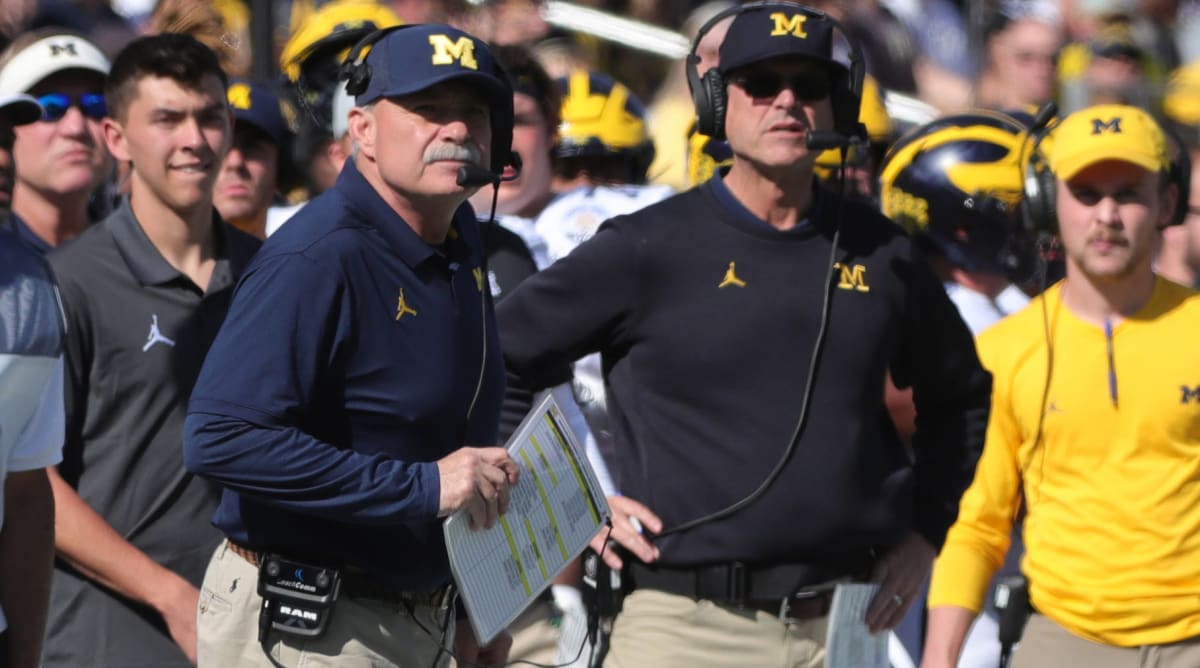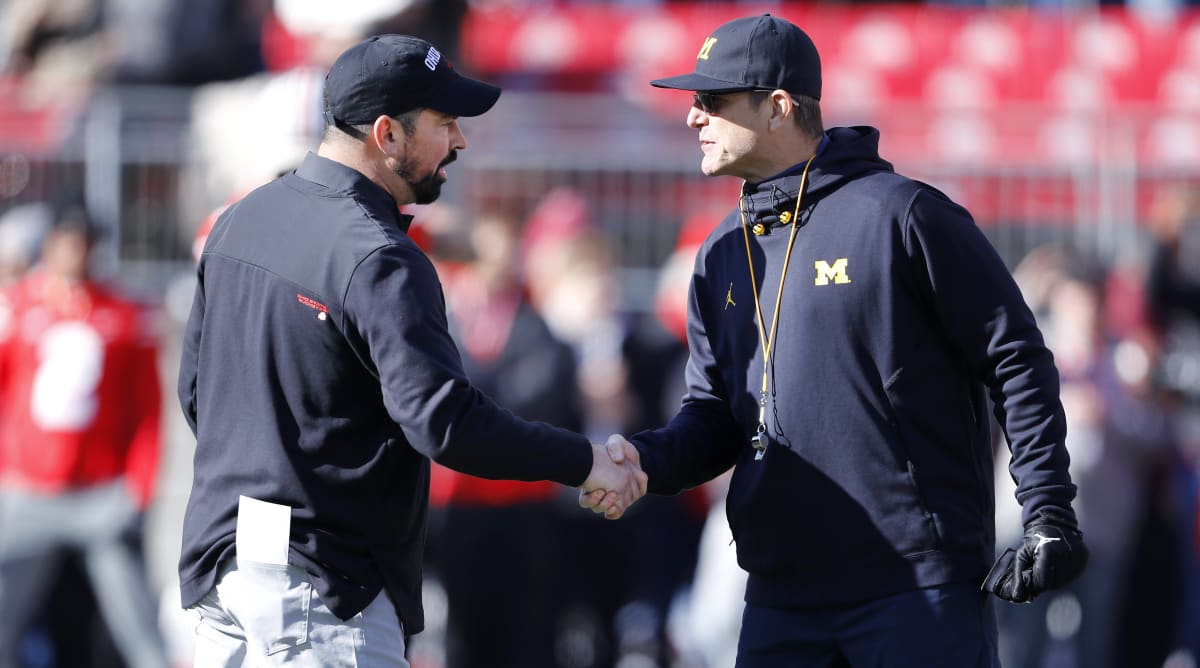How did Michigan turn its rivalry with Ohio State around?
It began with signal-stealing—but not in the way you might think.
Don Brown, Michigan’s defensive coordinator from 2016 to ’20, had no use for the dark art. His nickname was “Dr. Blitz,” and his scheme was based on constant pressure, man-to-man coverage and simplicity—allowing players to play freely and fast. Brown sent his own signals in from the sideline. He rarely changed them over the course of the season. Brown was 60 when Jim Harbaugh hired him, and he strongly believed that he knew how to call a defense. Brown bristled when anybody in the program suggested he could do a better job of disguising his calls, multiple people familiar with the dynamic at the time say.

Kirthmon F. Dozier/Detroit Free Press/USA TODAY Network
Brown’s Michigan defenses quickly dominated most of the Big Ten. In his first season, the Wolverines held the Buckeyes to 17 points in regulation before losing in overtime in Columbus. That offseason, Ohio State coach Urban Meyer made a shrewd hire: a young offensive coach named Ryan Day, who happened to have been Boston College’s offensive coordinator when Brown coordinated the Eagles’ defense.
In Day’s first season in Columbus, 2017, he was co–offensive coordinator and quarterbacks coach, but OC Kevin Wilson was the primary play-caller. Michigan countered with the worst full-season team of Harbaugh’s tenure; only the 2020 COVID-19 squad was worse. Ohio State beat Michigan in The Game, 31–20.
The perception at the time was that Harbaugh had the right defensive coordinator but hadn’t found his quarterback. That perception was about to implode.
In 2018, Michigan entered The Game first in the nation in total defense and favored by 4.5 points on the road. The Buckeyes were 10–1, but they had gotten smoked by Purdue and nearly lost to Maryland.
Harbaugh looked like he might finally beat his rival.
But Day was now the Ohio State play-caller, and the game was a replay of the same scene, again and again (and again and again):
The Buckeyes offense would get to the line of scrimmage.
Brown would send a signal to his defense, in full view of the Ohio State coaching staff.
Buckeyes quarterback Dwayne Haskins would look over to Day.
Day would call a play designed to beat Brown’s call.
Haskins threw for 396 yards, much of them on crossing patterns in the area of the field left open by Dr. Blitz. Haskins threw six touchdown passes and had no reason to launder his jersey afterward. Ohio State won, 62–39.
There is no indication that Day did anything illegal or unethical that day. There was no need. All he had to do was look over at Don Brown.
Harbaugh walked out of Ohio Stadium that day saddled with a dilemma that is unique to college football rivalries: His teams triumphed on most Saturdays, but not on the most important one. Should he make a slight change or a drastic one?
Firing Brown then would have looked like scapegoating. But there were two major problems with his scheme—one obvious, one subtle. The obvious problem was that Brown’s scheme relied on quickly blowing up plays, and it is hard to do that consistently against teams of equal or superior talent. The subtle problem was that it’s hard to develop an offensive identity when you practice against a relatively simple defense that is blitzing all the time. Scout-team defenses, by definition, are at a talent disadvantage.
It took Harbaugh two more years, but after a debacle of a 2020 season, he fired Brown and replaced him with Mike Macdonald, an assistant for John Harbaugh’s Ravens.
Meanwhile, Day had taken over for Meyer—and started shifting from Meyer’s vaunted power spread running attack to a pro-style offense built on vertical shots to elite receivers.
In 2017, the last year before Day started calling plays, Ohio State passed the ball 43% of the time. By 2021, the Buckeyes passed it 54% of the time.
Day’s offense has been wildly successful against most teams, but it comes with a price: Ohio State’s defense was no longer practicing against the same kind of power running game.

Joseph Maiorana/USA TODAY Sports
Harbaugh decided the best counterpunch to the kind of teams Day was building was to go retro. He revamped the entire Michigan program around a power running game, with the explicit purpose of being able to beat Ohio State.
A lot more goes into that than we see on Saturday. Macdonald and now co–defensive coordinators Jesse Minter and Steve Clinkscale run NFL-style defenses, which are not as blitz-heavy as Brown’s. This has allowed Michigan’s offense to develop an identity it never had when Brown was the defensive coordinator—and that, in turn, has toughened the Michigan defense, because now it has to face perhaps the best run-blocking offensive line in the nation at practice.
There has been a lot of discussion about whether Harbaugh’s dalliances with the NFL have hampered Michigan’s recruiting, and that’s a fair question. But there is another reason Michigan has not turned consecutive College Football Playoff berths into top-five recruiting classes: Harbaugh has focused on players who want to be part of the kind of team he has built, regardless of their ranking. The result is an extremely close group of players who love playing for him and one another.
And in the last two years, Michigan has run 76 times for 549 yards against Ohio State. The Buckeyes have run 59 times for 207 yards. The Wolverines won both games by double-digit margins.
Now Ohio State and Michigan are both undefeated again, and it is Day’s turn to counterpunch. Will he walk out of Michigan Stadium on Saturday with the biggest win of his career—or with a dilemma?







